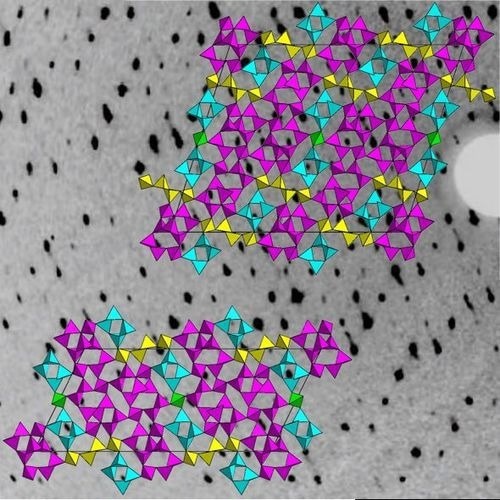Using X-Rays, it is possible to analyze the atomic structure of solid materials swiftly, easily, and with extreme precision. This, however, necessitates the existence of crystals of the relevant substances. Professor Oliver Oeckler, a chemist at Leipzig University, is working on techniques to enable this even for extremely tiny crystals that are invisible to the human eye.
 The image shows a section of the experimental data in the background, an X-ray diffraction pattern of the phosphorus oxide nitrides. In the foreground are sections of the crystal structure. These are networks of tetrahedra, each with phosphorus atoms in the center. Image Credit: Institute of Mineralogy, Crystallography and Materials Science, Leipzig University
The image shows a section of the experimental data in the background, an X-ray diffraction pattern of the phosphorus oxide nitrides. In the foreground are sections of the crystal structure. These are networks of tetrahedra, each with phosphorus atoms in the center. Image Credit: Institute of Mineralogy, Crystallography and Materials Science, Leipzig University
These include phosphorus oxide nitrides, which are synthetic compounds made of phosphorus, nitrogen, and oxygen. This unique class of compounds has peculiar features that have been hard to access up to this point due to their peculiar structures.
In collaboration with Professor Wolfgang Schnick of the Ludwig Maximilian University of Munich, Oeckler and his colleagues created a technique that allowed them to determine the intricate crystal structures of novel phosphorus oxide nitrides after ten years of research. The research was published in Chemistry-A European Journal.
Combining electron microscopy with synchrotron radiation—particularly powerful X-Rays produced via a unique method at a large research facility—is essential for analyzing crystal structure. However, the study of phosphorus oxide nitride demonstrates that this is occasionally insufficient.
For instance, the substance was already created for the first time in 2014, but its structure has not yet been determined since it was previously thought of as a class of compounds that was difficult to access. This substance might serve as the foundation for new phosphors in future research.
The riddle has finally been resolved by Daniel Günther, a Ph.D. researcher in Oeckler’s team and his mentor.
It was not due to the data, but to a trick of nature. We are not talking about just one substance, but three very complicated, intergrown compounds.
Daniel Günther, Study First Author and Postdoctoral Researcher, Leipzig University
A type of modular system was created by the atomic arrangement sections, from which complex and chaotic structures could develop.
Such an investigation requires extremely meticulous work, for which only a few staff members can muster the necessary patience and concentration. Without a research sabbatical and such a dedicated member of staff, it probably would not have worked. Most people would have been horrified by what at first glance appeared to be ‘unanalyzable’ data and would never have mentioned it again.
Oliver Oeckler, Professor, Materials Science and Crystallography, Faculty of Chemistry and Mineralogy, Leipzig University
He pointed out that the technique of analysis is just as important as the structure of oxonitridophosphates, which the researchers believe to be highly intriguing. Their study outlines a process that could be utilized to address similar analytical issues with entirely different substances.
Journal Reference:
Günther, D., et al. (2023) Modular Principle for Complex Disordered Tetrahedral Frameworks in Quenched High-pressure Phases of Phosphorus Oxide Nitrides. Chemistry-A European Journal. doi:10.1002/chem.202203892.